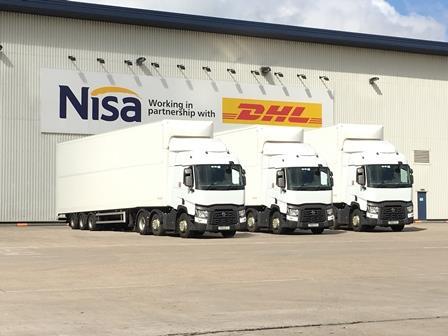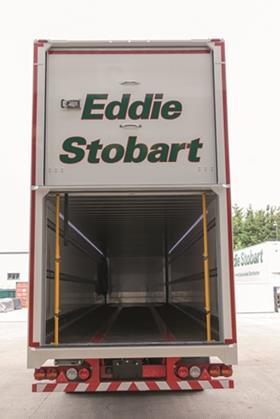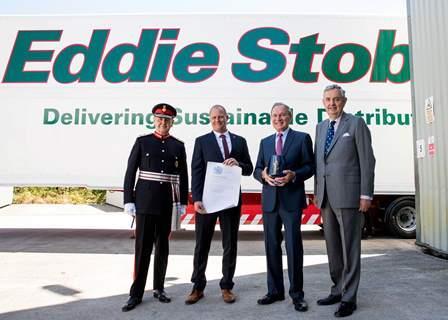
Based at its 35,000sq ft factory in Doncaster, Transdek is best known for its innovative ‘Wedge’ fixed double-deck trailers and rapid install, modular double deck lifts. Founder and CEO Mark Adams is on a mission to highlight the inefficiencies of many of the current crop of moving deck stepframe double-deckers, which he says are typically only able to carry up to 18 tonnes of payload and leave the tractor unit drive axle unstable.
For the past 26 years, his career focused on developing and promoting maximum volume and payload in HGVs. Transdek was founded in 1997, following the invention of a lift within the trailer to increase capacity. This was patented and licensed to Cartwright who built the trailers; Transdek fitted the internal lift into it. In 2004 the patent was sold Cartwright and Transdek started making external lifts tailored to loading double deck trailers as it saw the need for creating an instant lift.
These external lifts were designed to move roll cages and pallets from the upper deck of a fixed-deck double-decker to a standard loading dock or load and unload trailers from ground level without the need for a tail-lift.
“We were doing some work with Tesco, which was in the process of expanding its fleet of double-decks and converting from moving to fixed-deckers. They were excavating (at significant cost and delays) to put in massive scissor lifts next to the loading docks to service the two vehicle decks,” says Adams. “It was taking three months to complete this installation. What we created was the ability to make a pre-built, modular double deck loadhouse that could be installed in two days. It took about four years to develop.
“Tesco has probably got about 200 of our lifts, Boots have about 85 and Home Bargains around 25, as well as many other leading retailers.”
Cable and pulleys
The modular loadhouses, which use a robust and reliable cable and pulley system powered by a single hydraulic ram to move the lift, picked up the Motor Transport Best Use of Technology Award in 2009. More recently, Transdek has recently developed a remote monitoring system that can tell a transport manager at the despatching DC if the lift is fully operational before a fixed-deck trailer is sent hundreds of miles to unload.
“10 years ago we saw in a perfect world that everybody would be converting to fixed deckers, in which case they needed an interface,” says Adams. “At the time, we weren’t making trailers, we were just making the lifts. To us, this model makes the most sense. The trailer can be made as lightweight as possible, so you can optimise payload fill.”
Fixed v moving decks
Despite the advantages of using fixed double-deckers with a reliable external lift, the concept has been more often overlooked in favour of moving-deck trailers.
“Our biggest challenge over the last 10 years has been the growth of the moving-deck trailers. Operators are obviously looking for a solution that works best for them,” Adams says. “On the face of it, a trailer with its own internal lift that can be loaded from a fairly standard dock makes the most sense. Fixed deck trailers, on the other hand, either need a specialist lift at the loading bay or a tail-lift to be able to access the second deck.
“But the moving deck trailers typically offer at least 3 tonnes less payload, offset against the onboard hydraulics, and have higher capital and maintenance costs and more reliability issues.”
While the early moving decks suffered significant reliability problems, manufacturers have since ironed these out to an extent, but Adams points out that movement in the load during transit can still cause the second deck’s lifting mechanisms to lock.
“Yes, they are more reliable now but when the trailer corners and the load moves, there are still times when you can't get the top deck down at the delivery point. The theory is good, but the reality often is that it doesn't work so well,” he explains.
Despite these issues, powered deckers have become the dominant model in the industry. But Transdek believes that, over and above the issues of fixed versus powered decks, the whole focus on stepframe double deck trailers is fundamentally flawed in many cases.

“The inability to fully load the front of the trailer because of its reduced roof height causes a relative shift of payload on to the rear axles, which means that with anything other than lightweight products, the bogie overloads before the maximum combined vehicle weight is reached,” Adams argues. “A conventional, fixed deck stepframe double-decker carries roughly 20 tonnes. That's its capacity because of the over-loading on the rear bogey and the under-loading over the fifth wheel. A moving deck trailer carries more like about 17.5 tonnes, because of the added weight of the lift inside."
Less stable
Added to this is the relatively lighter load on the kingpin makes the whole artic unit less stable on the road.
“Eight or 10 years ago, double deck drivers were saying, ‘we can't get traction’. So one solution was to put 2 tonnes of concrete in the front, to try and put some more weight on the fifth wheel,” he goes on. “It just seemed wrong to put 2 tonnes in there, which still wasn't enough to give it traction. I believe it's just as dangerous to be under-loaded as over-loaded. It's dramatic - it's not like it's just half a tonne or so.
“The drive axle is under-loaded by 5 tonnes on a stepframe, whereas with a straightframe or wedge double-decker you're getting perfect load all the way through and you can run at 44 tonnes.”
With the support of leading operators such as Boots, Eddie Stobart, Nisa and Argos, Transdek developed the Wedge fixed double-decker with a patented ‘kink’ that allows 96 full-height 1,860mm roll cages to be loaded along the full length of both decks, exploiting the trailer’s full capacity and avoiding the problems with under-loading the drive axle of the tractor unit on stepframe trailers which cannot carry full-height pallets or cages at the front.

Eddie Stobart has long been a supporter of the Transdek Wedge concept, which increases capacity from 72 to 96 lightweight roll cages with a 13.6m length.
“A leading supermarket running fixed deck stepframe trailers is loading 67 roll cages which gives them 20 tonnes,” says Adams. “With the Wedge, we load 82 cages which gives 25 tonnes. It carries 15 roll cages and 5 tonnes more. On their moving deck trailers, the same retailer is loading less than 60 cages.”

The final touch was the development of sliding rear doors that can be opened with the trailer on the loading dock, saving time and increasing safety for the driver by avoiding the need to stop and open conventional barn doors before backing onto the dock.

Transdek is also putting the finishing touch to a safer version of a 1,500kg tail-lift that enables loading and unloading of the Wedge with no load dock or external lift. Transdek’s tail-lift has a number of extra safety features including a full guard rail and interlocks to prevent the lift getting jammed at ground level.
Transdek is currently building around five Wedge trailers a week onto various chassis, a number Adams hopes will be given a boost by recently being given the Queen’s Award for Enterprise 2018 in recognition of its innovative design.

When the Lord-Lieutenants of Nottinghamshire and South Yorkshire went to Transdek to present the Queen’s Award they asked Adams what he would wish for.
“Our wish would be that the government should pass the law that it's illegal to have lorries under-loaded on their drive axles,” Adams says. “That would just transform it. It would reduce accidents, make it much more comfortable for the drivers and reduce CO2 emissions and congestion at a single stroke.”
For certain lightweight applications like parcels and mail, the stepframe works well but for distribution operations needing to use the full height and weight capacity of the trailer the Wedge is a clear winner. It can have a dramatic impact on the delivered cost of goods to stores, potentially cutting transport costs by an additional 30% compared to powered deckers.
Backloads
Another issue that needs urgent attention with double-deckers is the difficulty in finding suitable backloads.
“If you talk to any of the retailers, almost without exception, they do not backload their double-deckers. Hardly any power deckers get backloaded,” says Adams. “It just seems criminal that they’re going out two thirds full to start with, and then coming back empty. In many cases, it would be more efficient just to carry on running single decks.
“With our Wedge, you can still backhaul say 26 pallets of drinks in the bottom deck, from a standard loading dock, as if it was a single decker.”














